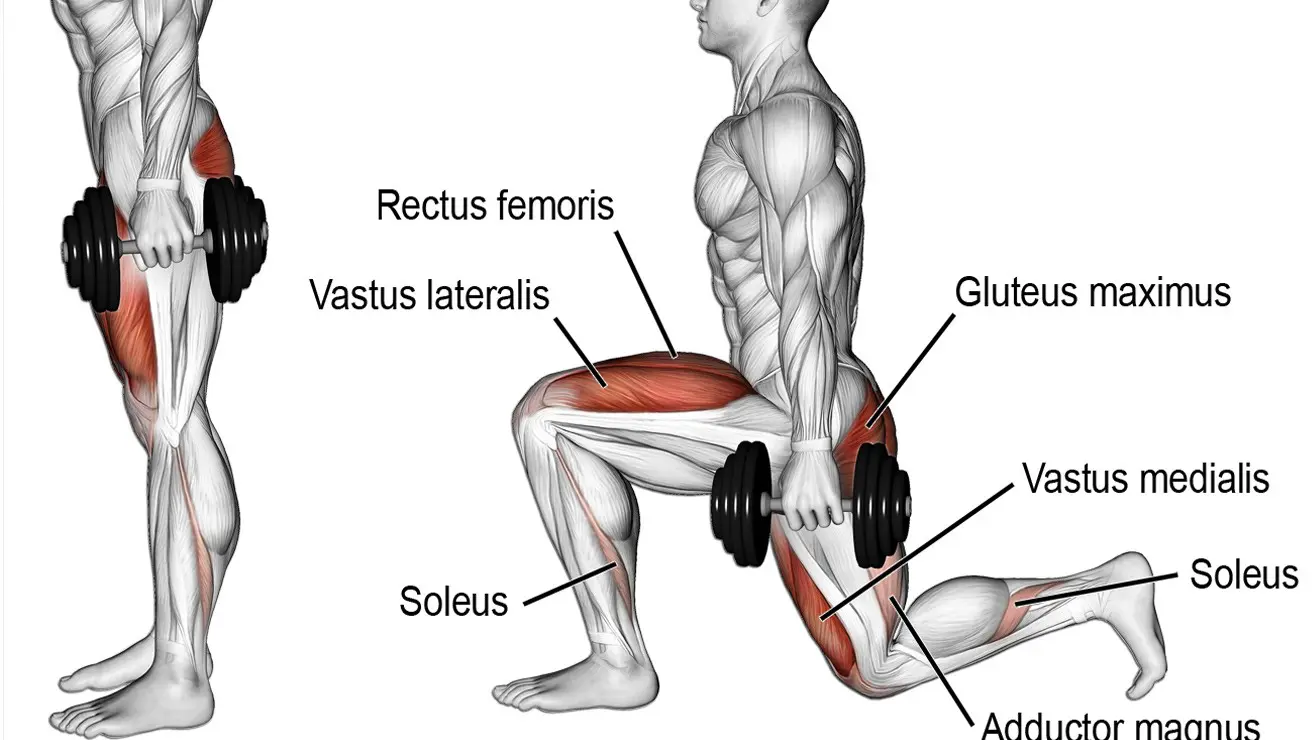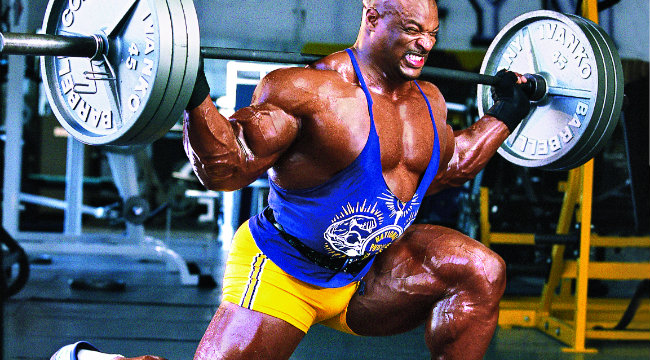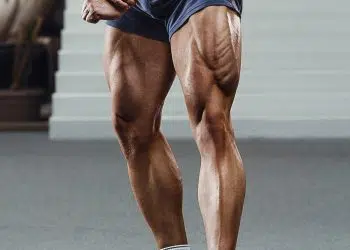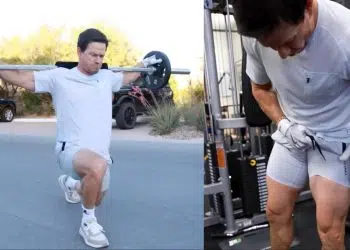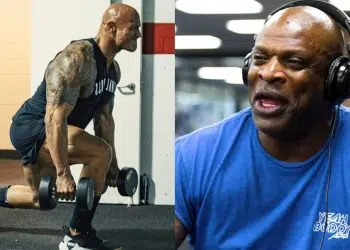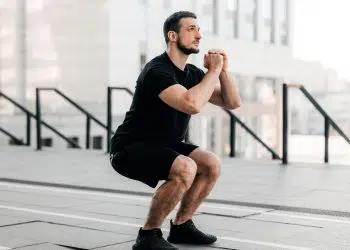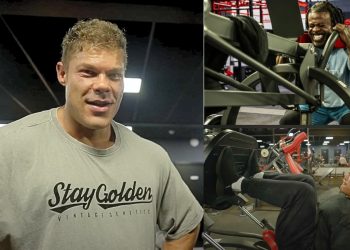When it comes to leg training, squats are the king of exercises. In fact, it’s hard to think of an effective bodybuilding or powerlifting leg workout that doesn’t contain some variation of squats.
But, as potent as squats are for building muscle and strength, they aren’t without drawbacks.
For example, to squat heavy loads, you definitely need to use a squat rack or power cage. Squats also compress your spine, which could make you shorter, albeit only temporarily.
Finally, squats are a bilateral or two-legged exercise. That means you could be using one leg more than the other, which could set you up for left-to-right leg strength and size differences.
None of this means that squats are bad; they really deserve their title king of the leg exercises. That said, smart lifters should supplement their squat workouts with a few additional lower body movements, such as lunges.
Lunges, you say, but they’re so boring!
Level Up Your Fitness: Join our 💪 strong community in Fitness Volt Newsletter. Get daily inspiration, expert-backed workouts, nutrition tips, the latest in strength sports, and the support you need to reach your goals. Subscribe for free!
The good news is there are plenty of lunge variations you can use to make sure your leg workouts are always productive and never, ever dull!
In this article, we reveal the 15 best lunge variations for bigger, more muscular legs.
Lunge Anatomy 101
Lunges are a compound exercise. That means they involve several muscles and joints working together. The main muscles developed by lunges are:
Quadriceps – located on the front of your thighs, there are four muscles in the quadriceps group: rectus femoris, vastus lateralis, vastus medialis, and vastus intermedius. All four quads extend your knees, while the rectus femoris is also a hip flexor.
Hamstrings – the three hamstring muscles are the biceps femoris, semimembranosus, and semitendinosus. Located on the back of your thigh, the hamstrings extend your hip and flex the knees.
Gluteus maximus – the glutes work with your hamstrings to extend your hips. Located on the back of your pelvis and basically your butt, this is the largest and potentially most powerful muscle in the human body.
Abductors and adductors – located on the outside of your hips and inside of your thighs, respectively, these muscles stabilize your hips to prevent your knees from falling in or out during lunges. There are also lunge variations that specifically target the abductors and adductors.
The 15 Best Lunge Variations
Not sure which lunge variations to add to your leg workouts? Here are 15 of the best!
Most of the following lunge variations can be done with or without weights. Hold dumbbells in your hands, rest and hold a barbell on your upper back, or wear a weighted vest to overload your legs.
0. Forward lunge
Before we reveal the best lunge variations, we need to cover how to do a basic, forward lunge. If you can’t do this exercise correctly, you probably aren’t ready for the different versions that come next!
So, if you are new to lunges or feel that your technique needs revising and perfecting, make sure you check out this guide to lunges before moving on to the other variations listed below.
1. Backward lunge
Forward lunges are a very quad-dominant exercise. Stepping backward increases glute and hamstring activation. In addition, backward (or reverse) lunges make it much easier to keep your front shin vertical and your knee well behind your toes. This can help reduce knee joint pain.
How to do it:
- Stand with your feet together, arms by your sides. Brace your core, pull your shoulders down and back, and look straight ahead.
- Take a large step backward, bend your legs, and lower your rearmost knee down to an inch above the floor. Lean forward slightly from your hips to avoid hyperextending your lumbar spine.
- Push off your back leg and return to the starting position.
- Repeat on the same leg or swap sides as preferred.
2. Walking lunge
Walking lunges involve a little more balance than regular lunges, increasing muscle engagement and making them slightly more functional. However, this variation could cause knee pain if you wobble too much. Walking lunges are a logical progression if you’ve mastered alternating forward lunges.
How to do it:
- Stand with your feet together, arms by your sides. Brace your core, pull your shoulders down and back, and look straight ahead.
- Take a large step forward, bend your legs, and lower your rearmost knee down to an inch above the floor.
- Push off your back leg and step forward into your next lunge. Alternate leading legs step by step.
- Continue for the prescribed number of reps or distance, e.g., 30 yards.
3. Step-through lunge
This exercise combines forward and backward lunges to provide an effective leg workout you can do anywhere and anytime. It also involves elements of walking lunges, but you don’t need a whole lot of space to do them. With several weight shifts per rep, this lunge variation is good for developing better balance.
How to do it:
- Stand with your feet together, arms by your sides. Brace your core, pull your shoulders down and back, and look straight ahead.
- Take a large step forward, bend your legs, and lower your rearmost knee down to within an inch of the floor.
- Push off your front leg and step straight back and into a rear lunge.
- Step forward into another front lunge and repeat.
- After completing the specified number of reps, rest a moment and then swap legs.
4. Deficit backward lunge
Deficit reverse lunges increase your range of motion, making the exercise more hip-centric. If you want to work your glutes and hamstrings more, this exercise is an excellent knee-friendly option. Start with a 4-6” deficit and increase from there.
How to do it:
- Stand on a stable 4 to 6-inch platform, such as an aerobic step top or a couple of stacked bumper plates. Stand with your feet together, arms by your sides. Brace your core, pull your shoulders down and back, and look straight ahead.
- Take a large step backward, bend your legs, and lower your rearmost knee down to an inch above the floor. Lean forward slightly from your hips to avoid hyperextending your lumbar spine.
- Push off your back leg and return to the starting position.
- Repeat on the same leg or swap sides as preferred.
5. Lateral lunge
The lateral or side lunge hits your inner and outer thighs and hips more than regular lunges. With forward and backward lunges, your abductors and adductors work mainly as stabilizers. But, with lateral lunges, these muscles are much more active and contribute to the movement. This is a good exercise for toning the inner and outer thighs, improving hip mobility, and is a valuable move for athletes, e.g., tennis players.
Read more about lateral lunges here.
Level Up Your Fitness: Join our 💪 strong community in Fitness Volt Newsletter. Get daily inspiration, expert-backed workouts, nutrition tips, the latest in strength sports, and the support you need to reach your goals. Subscribe for free!
6. Clock lunge
The clock lunge combines forward, backward, and lateral lunges to hit your legs from multiple angles. This is an excellent exercise for racket sports players and anyone who wants to improve their balance and coordination as they train their legs.
How to do it:
- Stand with your feet together, arms by your sides. Brace your core, pull your shoulders down and back, and look straight ahead.
- Take a large step forward, bend your legs, and lower your rearmost knee down to within an inch of the floor.
- Push off your front leg and bring your feet back together.
- Then, step sideways and into a lateral lunge. Push off your outer leg and bring your feet back together.
- Finally, step back and into a rear lunge. Push off your back leg and return to the starting position.
- Repeat this sequence with the other leg: Forward, sideways, and backward.
- Continue alternating legs for the desired number of repetitions.
7. Jumping lunge
Jumping lunges are a lower-body plyometric or power exercise. They involve a rapid load and stretch followed by an equally rapid contraction. If you want to run faster, jump higher, or just kick your leg workout intensity up a level, this is the exercise for you!
How to do it:
- Step forward and into a lunge. Bend your legs and lower your rear knee down to within an inch of the floor.
- Using your arms for momentum, jump up into the air and sweep your front leg backward and your rear leg forward, so you land with your feet reversed.
- Descend into another rep and repeat.
8. Short-step lunge
Lunges are an excellent total leg exercise, working your glutes, hamstrings, and quads pretty equally. However, done with a shorter step, they are much more quad-dominant. Do this exercise with a barbell or dumbbells, or just use your body weight for resistance.
How to do it:
- With or without dumbbells, stand with your feet together, arms by your sides. Brace your core.
- Take a small step forward with one leg, and then bend your knees. Keeping your torso upright, lower your rear knee down to within an inch of the floor.
- Push off your back leg and step through into another rep.
- Continue alternating legs for the required number of reps.
9. Forward leaning lunge
All types of lunge involve your glutes and hamstrings, but this variation is designed to emphasize your posterior chain even more. Leaning forward from your hips makes this exercise a little like single-leg Romanian deadlifts, but balancing is considerably easier. Make sure your lean comes from your hips and not by rounding your lower back, as doing so could cause injury.
Read more about this glute and hamstring-centric lunge variation here.
10. Cable forward lunge
Lunges are already a very effective exercise, and using a cable machine makes them even better! With this lunging variation, the cable pulls you forward, so you’ll have to work harder to decelerate as you descend and then push back to return to the starting position. This overloads your quads, leading to a more challenging workout.
How to do it:
- Attach a D-shaped handle or rope handle to a low pulley. Hold it with both hands and then take 1-2 steps back to tension the cable. Stand up tall, brace your abs, and pull your shoulders down and back.
- Take a large step forward, bend your legs, and lower your rearmost knee down to within an inch of the floor.
- Push off your front leg and return to the starting position.
- Do your next rep with the same leg or alternate sides as preferred.
- You can also use a cable machine to make backward lunges more challenging.
11. Static lunge
If regular lunges are a little too challenging for you right now, you may prefer static lunges, which involve less movement and coordination. Also known as split squats, this exercise is ideal for beginners and anyone whose balance is not as good as it could be.
It’s also a good option if you want to use heavier loads and don’t want to have to worry so much about stabilizing the weight.
How to do it:
- Stand with your feet together and your arms by your sides. Look straight ahead and stand up tall in good posture.
- Take a large step forward and then stop.
- With your abs braced and your torso upright, bend your legs and lower your rearmost knee down to within an inch of the floor. Your front shin should be close to vertical and your leading knee behind your toes.
- Without moving your feet, stand back up, pause, and then descend again.
- Keep going until you have completed the prescribed number of reps.
- On completion, either step forward or backward to bring your feet back together.
- Rest a moment and then repeat on the opposite leg.
Learn how to do split squats in our in-depth guide.
12. Non-alternating walking lunge
While regular alternating walking lunges (exercise #2) are a great exercise, swapping legs step by step means your muscles get a brief rest between reps. This non-alternating variation provides a little more overload and increases time under tension, which may be helpful for hypertrophy.
How to do it:
- Stand with your feet together and your arms by your sides. Look straight ahead and stand up tall in good posture.
- Take a large step forward, bend your legs, and lower your rear knee to within an inch of the floor.
- Push off your back leg and bring your rear foot up to your front foot.
- Step forward with the same leading leg and repeat.
- Continue for the prescribed number of reps, rest a moment, and then do the same number of reps with the opposite leg in front.
13. Rotational lunge
While all lunge variations involve an element of core engagement, this variation is much more core-centric. In addition, rotational lunges are more challenging for your balance. This exercise is beneficial for racket sports players, such as tennis, as well as golfers.
How to do it:
- Stand tall with your feet together and your hands by your sides. Look straight ahead and not down at the floor. Hold a weight in your hands, such as a medicine ball. Raise your arms overhead and brace your abs.
- Take a large step forward, bend your legs, and lower your rear knee down to within an inch of the floor.
- Simultaneously lower your arms and turn toward your leading leg. Lower the weight to the outside of your front thigh.
- Push off your front leg, return to the starting position, and repeat. Alternate leading legs rep by rep or do all your reps on the same side before switching as preferred.
14. Curtsey lunge
Don’t think for a minute that curtsey lunges are in any way effeminate. In contrast, they’re a demanding variation of reverse lunges that hits your hips and glutes hard. This is also a good exercise for developing better balance.
How to do it:
- Stand with your feet shoulder-width apart and your arms down at your sides.
- Putting your weight on your right foot, step back and around with your left foot — almost as if you’re curtsying. Descend until your right thigh is roughly parallel to the ground.
- Straighten your right leg, pushing up through your heel, and return to the starting position.
- Repeat for the desired number of reps, then switch legs.
15. Paused lunge
Make almost any type of lunge harder by adding a 2-3 second pause at the bottom of each rep. Just stop and hold your rear knee an inch above the floor to increase your time under tension.
This is an excellent option for anyone looking to make their workouts more demanding without resorting to lifting heavier weights. Adding a mid-rep pause also means you’ll have to work harder to maintain your balance.
Lunge Variations – Wrapping Up
A lot of lifters do lunges as a secondary leg exercise, often using light weights for high reps. Others dismiss lunges altogether, believing that they’re not an effective muscle builder.
Ronnie Coleman knew differently and often did heavy walking lunges as part of his leg mass-building workouts.
We’re not suggesting for a minute that you should give up squats and leg presses. That would be sacrilegious! But, as King Ronnie showed, lunges can be effective for building bigger legs, and they should be treated as more than just a workout afterthought.
Try doing one of these 15 lunge variations BEFORE squats or leg presses, using heavier weights and for lower reps. Your legs will be shocked into new levels of growth.
Interested in measuring your progress? Check out our strength standards for Dumbbell Lunge, Deadlift, Side Lunge, and more.

